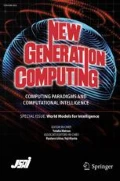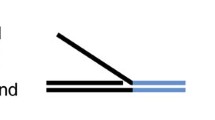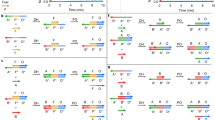Abstract
Nanomechanical devices are driven by chemical and/or physical signals, which exert their functions by transitioning between different molecular states. Many DNA-based nanomechanical devices proposed so far are typically driven by applying single-stranded DNAs representing instructions. To use these devices, it is necessary to manually deliver the strands in a step-by-step manner or use an external computerized apparatus to supply the strands. In this work, we propose an elaborate DNA reaction system capable of generating a sequence of multiple single-stranded DNAs according to a given program which is also a single-stranded DNA. The system is designed as a cascade of DNA hybridization and enzymatic reactions, in which the whole reaction is triggered by the program strand. The system can generate single-stranded DNAs one by one in a sequential order written on the program strand. We experimentally demonstrated the feasibility and the scalability of the system, by using the program strands encoding instruction sequences of different lengths.




Similar content being viewed by others
References
Adleman, L.: Molecular computation of solutions to combinatorial problems. Science 266(5187), 1021–1024 (1994)
Antipova, V.N., Zheleznaya, L.A., Zyrina, N.V.: Ab initio DNA synthesis by bst polymerase in the presence of nicking endonucleases nt.AlwI, nb.BbvCI, and nb.BsmI. FEMS Microbiol. Lett. 357(2), 144–150 (2014). https://doi.org/10.1111/1574-6968.12511
Bath, J., Turberfield, A.J.: DNA nanomachines. Nat. Nanotechnol. 2(5), 275–284 (2007)
Benenson, Y.: Biomolecular computing systems: principles, progress and potential. Nat. Rev. Genet. 13(7), 455–468 (2012)
Benenson, Y., Gil, B., Ben-Dor, U., et al.: An autonomous molecular computer for logical control of gene expression. Nature 429(6990), 423–429 (2004)
Crick, F.: Central dogma of molecular biology. Nature 227, 561–563 (1970)
Fu, T., Lyu, Y., Liu, H., et al.: DNA-based dynamic reaction networks. Trends Biochem. Sci. 43(7), 547–560 (2018)
Fujii, T., Rondelez, Y.: Predator–prey molecular ecosystem. ACS Nano 7(1), 27–34 (2013)
Gu, H., Chao, J., Xiao, S.J., et al.: A proximity-based programmable DNA nanoscale assembly line. Nature 465(7295), 202–205 (2010)
He, Y., Liu, D.R.: Autonomous multistep organic synthesis in a single isothermal solution mediated by a DNA walker. Nat. Nanotechnol. 5(11), 778–782 (2010)
Jung, C., Allen, P.B., Ellington, A.D.: A simple, cleated DNA walker that hangs on to surfaces. ACS Nano 11(8), 8047–8054 (2017)
Kageyama, R., Kawamata, I., Tanabe, K., et al.: Construction of T-motif-based DNA nanostructures using enzymatic reactions. ChemBioChem 19(8), 873–876 (2018)
Khalil, A.S., Collins, J.J.: Synthetic biology: applications come of age. Nat. Rev. Genet. 11(5), 367–379 (2010)
Kishi, J.Y., Schaus, T.E., Gopalkrishnan, N., et al.: Programmable autonomous synthesis of single-stranded DNA. Nat. Chem. 10, 155–164 (2018)
Komiya, K., Komori, M., Noda, C., et al.: Leak-free million-fold DNA amplification with locked nucleic acid and targeted hybridization in one pot. Org. Biomol. Chem. 17(23), 5708–5713 (2019)
Li, J., Green, A.A., Yan, H., et al.: Engineering nucleic acid structures for programmable molecular circuitry and intracellular biocomputation. Nat. Chem. 9, 1056–1067 (2017)
Liao, S., Seeman, N.C.: Translation of DNA signals into polymer assembly instructions. Science 306(5704), 2072–4 (2004)
Lund, K., Manzo, A.J., Dabby, N., et al.: Molecular robots guided by prescriptive landscapes. Nature 465(7295), 206–210 (2010)
Meng, W., Muscat, R.A., McKee, M.L., et al.: An autonomous molecular assembler for programmable chemical synthesis. Nat. Chem. 8(6), 542–548 (2016)
Padirac, A., Fujii, T., Rondelez, Y.: Bottom-up construction of in vitro switchable memories. Proc. Natl. Acad. Sci. 109(47), E3212–E3220 (2012)
Qian, L., Winfree, E., Bruck, J.: Neural network computation with DNA strand displacement cascades. Nature 475(7356), 368–372 (2011)
Scalise, D., Rubanov, M., Miller, K., et al.: Programming the sequential release of DNA. ACS Synth. Biol. 9(4), 749–755 (2020)
Seelig, G., Soloveichik, D., Zhang, D.Y., et al.: Enzyme-free nucleic acid logic circuits. Science 314(5805), 1585–1588 (2006)
Seeman, N.C., Sleiman, H.F.: DNA nanotechnology. Nat. Rev. Mater. 3(17), 068 (2017)
Shin, J.S., Pierce, N.A.: A synthetic DNA walker for molecular transport. J. Am. Chem. Soc. 126(35), 10834–10835 (2004)
Soloveichik, D., Seelig, G., Winfree, E.: DNA as a universal substrate for chemical kinetics. Proc. Natl. Acad. Sci. 107(12), 5393–5398 (2010)
Srinivas, N., Parkin, J., Seelig, G., et al.: Enzyme-free nucleic acid dynamical systems. Science 358, eaal2052 (2017)
Suzuki, Y., Kawamata, I., Mizuno, K., et al.: Large deformation of a DNA-origami nanoarm induced by the cumulative actuation of tension-adjustable modules. Angew. Chem. Int. Ed. 59(15), 6230–6234 (2020)
Tanaka, F., Kameda, A., Yamamoto, M., et al.: Design of nucleic acid sequences for DNA computing based on a thermodynamic approach. Nucleic Acids Res. 33(3), 903–911 (2005)
Thubagere, A.J., Li, W., Johnson, R.F., et al.: A cargo-sorting DNA robot. Science 357(6356), eaan6558 (2017)
Tian, Y., He, Y., Chen, Y., et al.: A DNAzyme that walks processively and autonomously along a one-dimensional track. Angew. Chem. Int. Ed. 44(28), 4355–4358 (2005)
Tomaru, T., Suzuki, Y., Kawamata, I., et al.: Stepping operation of rotary DNA origami device. Chem. Commun. 53, 7716–7719 (2017)
Tomov, T.E., Tsukanov, R., Glick, Y., et al.: DNA bipedal motor achieves a large number of steps due to operation using microfluidics-based interface. ACS Nano 11(4), 4002–4008 (2017)
Wickham, S.F.J., Endo, M., Katsuda, Y., et al.: Direct observation of stepwise movement of a synthetic molecular transporter. Nat. Nanotechnol. 6(3), 166–169 (2011)
Wickham, S.F.J., Bath, J., Katsuda, Y., et al.: A DNA-based molecular motor that can navigate a network of tracks. Nat. Nanotechnol. 7(3), 169–173 (2012)
Yurke, B., Turberfield, A.J., Mills, A.P.J., et al.: A DNA-fuelled molecular machine made of DNA. Nature 406(6796), 605–608 (2000)
Zhang, D.Y., Winfree, E.: Control of DNA strand displacement kinetics using toehold exchange. J. Am. Chem. Soc. 131(47), 17303–17314 (2009)
Acknowledgements
The authors appreciate Shawn Douglas for holding BIOMOD competition where we began this research. We thank the member of BIOMOD team of Tohoku University to come up with the first preliminary idea of the project, who are Shota Kawakami, Yu-chin Chen, Shogo Hiratsuka, Sho Aradachi, Daisuke Tamatsuki, Hayato Yuuki, Takuto Takahashi, Eiki Ishihara, Shunsuke Imai, Hayato Otaka, Yuto Otaki, Kenta Suzuki, Taiki Watanabe, Fumi Takabatake. We also thank Kaori Tanabe for helping the experiment. This work was supported by JSPS KAKENHI Grant numbers 15H01715, 18K18144, 19KK0261, 20H00618, 20H00619, 20H05701, 20H05968, 20H05969, 20H05970, 20H05971, 20K20979, and the 51st Research Grants in the Natural Sciences of Mitsubishi Foundation.
Author information
Authors and Affiliations
Corresponding author
Additional information
Publisher's Note
Springer Nature remains neutral with regard to jurisdictional claims in published maps and institutional affiliations.
Appendices
Appendix A: Experiment
All DNAs were purchased from Eurofins Genomics Japan. The sequences of DNA are listed in the Table 1. The concentration of DNA in the initial state was 200 nM for all experiments, unless otherwise specified. To stabilize the DNA complex, all the DNA samples were annealed from 95 to 20 \({}^\circ \)C by a temperature ramp of \(-1~{}^\circ \)C per 1 min. For enzymes, we used Bst polymerase (New England Biolabs), Nt.BstNBI (New England Biolabs) for nickase, and EcoRI (Takara, Japan) restriction enzyme for endonuclease activity. The concentration of enzymes were 80, 200, 150 U/mL for polymerase, nickase and restriction enzyme, respectively. The concentration of dNTP was 0.8 mM. All reactions were carried at 45 \(^\circ \)C in H buffer (TAKARA BIO). After an incubation of prescribed time, the reactions were stopped by inactivating enzymes at 80 \(^\circ \)C for 10 min, followed by a gradual annealing from 95 to 25 \(^\circ \)C by \(-1~{}^\circ \) per 1 min. The gel was imaged by ChemiDoc (BIO-RAD) and analyzed by ImageLab (BIORAD) and ImageJ (NIH, USA).
Appendix B: Sequence of DNA
Sequences of DNAs are listed in the following table. The 3\(^{\prime }\)-ends of template, output, transducer, gate, update, and adjuster were phosphorylated, unless otherwise specified.
Appendix C: Raw Gel Electrophoresis Data
Details of step-by-step experiments are summarized in Fig. 5. Although Bst polymerase, Nt.BstNBI, and EcoRI have recommended reaction temperatures of 65, 65, and 37 \(^\circ \)C, respectively, all of the enzymes show activity under 45 \(^\circ \)C.
Gel electrophoresis images that show the reaction of each process. Each image corresponds to the reactions a from 2 to 4, b from 5 to 6, c from 7 to 8, and d from 10 to 13. DNA strands in a, c, and d were stained by SYBR GOLD, while fluorescence of TAMRA which was modified to the 3\(^{\prime }\)-end of output is detected in b. The presence and absence of corresponding DNA structure or enzyme is represented by plus and minus
The result of a single-instruction system is shown in Fig. 6.
The effect of phosphorylations is summarized in Fig. 7.
The raw gel electrophoresis data for the three instruction systems are summarized in Fig. 8, which are used to make the graphs of Fig. 3.
About this article
Cite this article
Kawamata, I., Nomura, Si.M. & Murata, S. Autonomous and Programmable Strand Generator Implemented as DNA and Enzymatic Chemical Reaction Cascade. New Gener. Comput. 40, 723–736 (2022). https://doi.org/10.1007/s00354-022-00156-4
Received:
Accepted:
Published:
Issue Date:
DOI: https://doi.org/10.1007/s00354-022-00156-4








